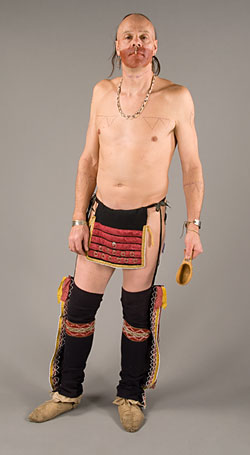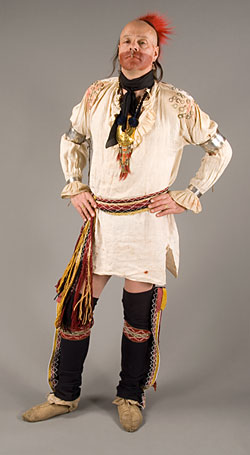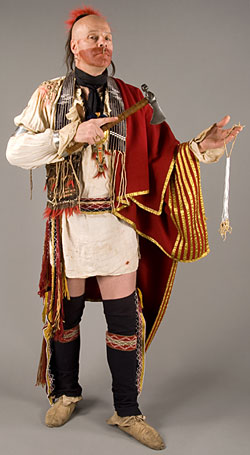




Advanced Search
Dress Up | 1st Person | African American Map | Now Read This | Magic Lens | In the Round | Tool Videos | Architecture | e-Postcards | Chronologies Turns Activities
Wôbanaki Men's Clothing from 1770By 1770, some Wôbanaki people, especially those in French or English towns, were beginning to live in a manner very similar to that of the French and English. They often wore the same style of clothes, lived in the same kinds of houses, had many of the same types of possessions, and by outward appearance, did not appear to be dramatically different. Most Native people, however, kept some elements of tradition, by wearing moccasins and leggings, decorating their clothing with silver ornaments, or keeping their hair long. Some chose to keep traditional ways of life, and acquire just a few European items. Such is the case for the man described here, who wears a few items of clothing from the French Canadian people. Wôbanaki people did not have special clothing for sleeping. They would sleep in what seemed most suited for the season. In the winter this would mean wearing several layers to bed and in the hot weather one might sleep without clothing. Hairstyles differed from group to group. In general, men living further north tended to keep their hair longer because the climate was cooler. Hairstyles would also change over the course of one’s life to reflect personal taste, or to signify alliance or mourning. Wôbanaki people believed it was a good idea to protect sensitive areas of the body, such as joints, the neck, ears and face, with jewelry, garters, and tattoos. By these means, they believed that dangerous energy or spirits could not enter their bodies. Jewelry with complicated patterns, reflective surfaces, and dangling and jangling pieces such as bells or metal cones, all helped to confuse harmful forces. Porcupine quill embroidery, beading, fringe, and ribbons might be added to the edges of clothing, both to offer protection and to encourage connections with desirable plants and animals. For instance, the edge of a breechclout might be decorated with ribbons, or the flaps on a pair of moccasins might be decorated with beads or porcupine quill embroidery. Among the numerous items available through trade in the 1770s were wool and linen cloth, ready-made shirts and coats, knitted wool hats and mittens, felted wool hats, glass beads, silver jewelry, brass kettles, paint pigments such as vermillion, and metal axe and spear heads and knife blades. Native American people in New England would trade with the French in New France or the English in the American colonies. Items they received might come from England, France, Holland, or as far away as India. or China. Go to interactive Flash version
Breechclout or BreechclothA breechclout, called “adhozoan”, is a strip of fabric or deerskin that goes between the legs and is held in place by a belt tied around the waist. The breechclout might be compared to modern-day shorts, underwear or bathing suit. This man's breechclout is made of wool, decorated with silk ribbons and silver trade pins. It is interesting to note that wool cloth used for clothing was usually either red or blue. LeggingsThese are wool leggings, called “medasal”, decorated with silk ribbons and glass beads. The leggings are tied to a belt at the waist to keep them up. Leggings were worn for warmth and to protect one's legs when walking through scratchy undergrowth. MoccasinsThese are summer-weight moccasins with a center seam. They are made from the hide of a white-tailed deer. The Abenaki call all kinds of shoes "mkezenal". The English adapted this word into “moccasin”. BeadsThese wampum beads (cylindrical beads used for jewelry, ceremonies, and currency) are made of glass. The Abenaki word for wampum bead is "wôbôbial". Face PaintFace paint was used for a variety of reasons, including for disguise or to convey a mood or emotion. This man wears red paint to show that he is feeling happy. Red was associated with life, victory, blood, war, or enthusiasm. TattoosTattoos were put on the body for a variety of reasons. Some were marks of valor, and others were used to cover skin injuries. Some tattoos, such as those across the chest of the man shown here, served as barriers against evil spirits. Tattoos were often placed on powerful parts of the body such as around the eyes, on the chest, joints, or the fingers used to draw a bow or pull the trigger of a gun. Tattoos were also used to deaden nerves, to relieve various aches, and to attract healing energy to specific parts of the body.
CupThe man holds a wooden cup for food or drink. It might have been made by himself or by one of his male relatives. The Abenaki word for a personal wooden scoop or cup is “amkwôn”; in Algonkian, the word for a wooden cup is "noggin". These cups were useful for collecting drinking water from a spring or other fresh water source while traveling.
ShirtThis man's shirt, called a “wihibaks”, is made of linen and has ruffles at the neck and sleeves. It is the same style worn by European men for formal occasions, but they would wear theirs tucked into their breeches. This man's shirt has been decorated with silver trade pins called "brooches". Nose RingThis man pierced his nose in order to wear a nose ring. This ring is made of silver. KerchiefThis is a silk kerchief. The silk would have been imported from India. RoachThis hairpiece is called a "roach". It is made of dyed red hair from the tail of a buck deer. The Penobscot word for roach is "wesewal", which means "faith". A roach was an important and deeply meaningful ornament.
EarringsThese earrings are made of silver with wampum beads. People often slept with their earrings on. Earrings are called “saksohanal”.
Arm Bands & BraceletsJewelry was worn by men and women. These bracelets and armbands,called “wpedinibial”, are made of silver.
Sash & GartersThis man wears garters, called “kiganibial”, just under his knees. They help to keep his leggings in place. He also wears a sash around his waist. The sash and garters are made from wool yarn, using a technique called "fingerweaving". As the name suggests, fingerweaving is a way to weave by using just the fingers. The sash and garters are decorated with glass beads, which were sewn on after they were woven.
KnifeA knife could be used for a variety of tasks, from cutting food to carving wood. The sheath is decorated with embroidery of flattened, dyed porcupine quills, white glass beads, and tufts of deer hair dyed red and placed in cones made from a copper kettle that was cut up to make jewelry. The cones would serve as bells, making a pleasant noise when the sheath moved.
Match CoatA match coat is a blanket used as a cape or shawl. When used as a blanket, it’s a “maksa”; when used as an overcoat, it’s a "kchi pikizon". This one has been decorated with silk ribbon.
Axe/PipeThis metal axe serves a dual purpose. It can be used for cutting or smoking. There is a pipe bowl on the end opposite the blade. In diplomatic contexts, pipes like these signaled the delicate balance between war and peace.
Wampum Belt & Talking StringsAround this man's neck is a wampum belt. It is composed of glass beads. In Abenaki, the word for wampum belt is "wôbôbial". Dark beads signify anger, sadness, conflict or complexity. It would give an important, serious message to someone receiving it. The ends of the belt are knotted; among the Wôbanakiak, this might symbolize a personal belt belonging to this man. The talking strings were used for peaceful purposes and served as memory devices. White signifies peace, clarity, calmness, and friendship. Each strand might stand for part of a message, inviting and welcoming visitors and wishing them health.
PouchThis deerskin pouch is decorated with tufts of deer hair dyed red, embroidery of flattened, dyed porcupine quills, blue and white glass wampum beads, and cones made from a copper kettle. The cones would serve as bells, making a pleasant noise when the pouch moved. The pouch's contents include bullets, a steel striker with flints, and a magnifying lens. When a piece of flint is struck against a striker, sparks are produced that can be used to start a fire. If the lens is held at a certain angle to the sun, focusing the sun’s rays onto something flammable such as a piece of tree fungus, it could generate enough heat to start a fire. On the right side, from top to bottom, are tobacco rolled up in paper, a screwdriver for use with a gun, a spring for cleaning a gun, and a stone pipe.
|
| |
Home | Online
Collection | Things
To Do | Turns Exhibit | Classroom | Chronologies My
Collection
About This Site | Site
Index | Site Search | Feedback










